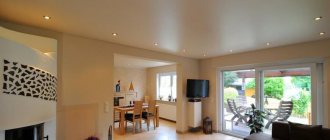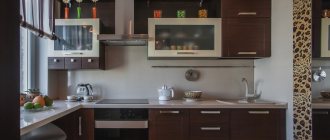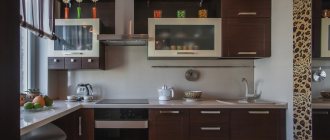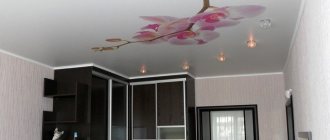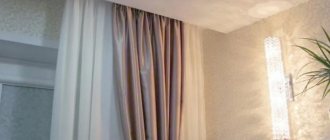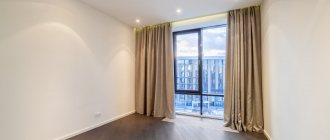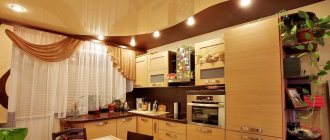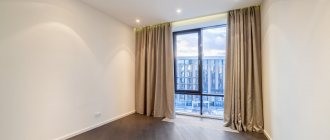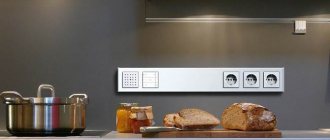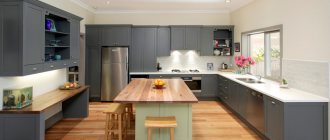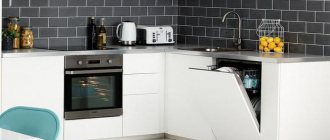Properly installed PVC sheets will ensure their correct operation for many years. However, completely different factors influence how they fit into your interior. Among them, in the first place is the competent organization of lighting, on which the overall atmosphere in the room and the visual harmony perceived in it often depend. Basic diagrams and photos with examples from interiors will help you, which will help you achieve the optimal location of spotlights on a suspended ceiling.
- Spot location rules
- Spot layouts with a chandelier
- Spot layouts without a chandelier
- Options for placing lamps in different rooms
- Conclusion
Installation specialists call these lamps differently: mortise, spot
, spotlights, spotlights, recessed and so on. However, the essence does not change - in many ways, they play the main role in creating a unique lighting scenario in a room, helping to emphasize certain areas.
In light of such popularity of spotlights, many have somehow completely forgotten that their original purpose is to serve as additional lighting in the living space, where the chandelier located in the center rules the roost .
.
However, the latter is increasingly being ignored as a light source. Not in all cases this can be considered justified, but often constructing a light pattern in a room exclusively with the help of spots can be considered successful.
Spot location rules
True, in order to squeeze the maximum aesthetic appeal from the mounted panel, you need to know the basic rules for the safe placement of spots on a stretch ceiling. Let's try to list below those that are considered basic:
- if the spots are located along the wall, then maintain the minimum distance required for high-quality light dispersion - 20 cm. If you ignore this recommendation, you will not be able to get the level of illumination you want from the mounted lamps;
- the recommended distance between spots is from 30 centimeters, the optimal one is determined by local need and the type of stretched panel;
- parallel placed spotlights visually lengthen the room - this can be successfully used for rooms that need some visual correction;
- a rectangular arrangement is ideal for small and narrow rooms, but most often requires support in the form of “heavy artillery” - a weighty chandelier in the center;
- if you use spots in connection with stretch ceilings made of ordinary PVC film, then the maximum permissible power for halogen lamps is up to 20 W, for a satin panel a little more - up to 35 W;
- the exact number of lamps is always determined by the type of light pattern in the room, but one spot can illuminate no more than 2 m2 of free area. This figure must be kept in mind when drawing up a plan for the placement of spotlights on a suspended ceiling.
Basic rules, recommendations and accommodation features
Everyone is free to choose where to place lighting fixtures on the ceiling, but one should take into account technical nuances, as well as basic marking rules:
- Lighting devices must create a certain level of illumination for one or another part of the room. For example, there is a place for bright light above the work area; in a resting place, it is better to make the lighting “muffled”; if it is not enough, you can always install additional lighting (table lamp, floor lamp, sconce, etc.).
- It is necessary to adhere to general standards when placing ceiling spotlights:
- If the lighting is located around the perimeter of the room, then the minimum distance from the spots to the walls should be at least 20.0 cm. Deviation from this rule will lead to deterioration in light dispersion and possible “overheating” of the wall surface.
- There should not be less than 30.0 cm between nearby lamps. Depending on the design of the lighting fixtures, the material of the ceiling surface, as well as other factors, this standard can be revised, as a rule, upward.
We have listed the basic standards for any type of suspended ceiling covering, now let’s move on to the specifics.
Spot layouts with a chandelier
No matter how archaic a chandelier sometimes looks, sometimes without it some rooms look downright boring.
The use of spots as additional lighting does not at all downplay their role as light sources. As can be seen from the set of the most common schemes, they are responsible for zoning the room and the necessary lighting of certain areas noticeably distant from the central chandelier.
Let's look at how this is implemented in practice.
Spot layouts without a chandelier
In a number of rooms, spotlights take on the main role in organizing lighting due to the lack of possibilities for installing a central chandelier. Also, the latter can often look like a foreign element in certain interiors, for example, in a narrow corridor or a small bathroom. In cases where the use of a chandelier is inappropriate, the correct placement of spot spots on a stretch ceiling takes on additional importance.
The most common options for using spots in such cases are discussed in detail in the diagram below.
Again, this is what it looks like in a variety of interiors.
Options for placing lamps in different rooms
It is quite easy to learn how to correctly distribute spotlights over the entire area of a stretch ceiling - to do this, you just need to try to imagine the final light pattern of the room. But teaching this is a dubious idea. Too many different pitfalls come to the surface, and circumstances that are not obvious to everyone begin to directly influence the nature of their location on the stretch ceiling. Nevertheless, some general tips for functionally different rooms remain valid.
In the bedroom
Don't try to break all lighting power records. The bedroom is a room for sleeping, one of the most peaceful places in your apartment or home, so the first priority is to create a calm, sleep-inducing atmosphere. If you use the option with a central chandelier on a suspended ceiling, you can use spotlights to highlight the area near the mirror or the bedside table. It's practical!
Often in the bedroom you can limit yourself to just spotlights on suspended ceilings. A good tip is to use yellow light. It is not as bright as classic white and will never irritate you.
In the living room
If there is any factor limiting your creative imagination when arranging spotlights in this room, then, as the photo shows, it comes down to the area of the ceiling surface. Here you can use a variety of lighting options, including dynamic brightness
.
Large living rooms can be successfully divided into zones. The chosen arrangement of spotlights on stretched canvases will most often depend on the style of interior design. For minimalism, which has now gained particular popularity, strict geometry and symmetry are most relevant. For classics - some smoothing of the corners.
Kitchen
Additional lighting of the dining or work area on a suspended ceiling using spotlights is one of the techniques that allows you to create a special mood and comfort in this room.
Otherwise, spotlights in the kitchen are often located along the installed set - this option has some kind of tradition, but very often due to the modest size of the kitchen as a whole. And, as a result, very little room for maneuver.
However, there are also quite original ways of arranging spots on a suspended ceiling - in the photo below.
Bathroom/Toilet
The final choice depends on your personal preferences. Are you an adherent of clear symmetry and tend to be a perfectionist? The geometric distribution will fit exactly into your taste pattern.
Do you prefer freedom of movement and non-trivial, sometimes even unexpected solutions? You can do it as in the photo below.
Still, it is difficult to neglect one piece of advice, which for such a purely functional room as a bathroom takes on special significance: if the mirror you are using does not have its own lighting, then you can, with a clear conscience, use the principle of zoning and place a confident emphasis on this piece of your interior.
Hallway/Corridor
We have already discussed some of the nuances of the placement of lamps on a suspended ceiling in the corridor above. Let us explain the idea more broadly: some narrowness of the corridor space, coupled with poor lighting, causes discomfort for both you and your guests, which is quite logical. You can avoid this with a little trick: place the spots on the ceiling perpendicular to the walls of the corridor, thus forming a classic rectangle, and the idea of your dull and uncomfortable corridor will suddenly change dramatically.
In the same way, you can make a tiny hallway visually a little larger due to the now parallel placement of spots
on a suspended ceiling - exactly along the walls. The space will lengthen, and your guests will be able to feel at least a little freer. Yes and you too!
Lamps used for lighting in the kitchen with a suspended ceiling
When choosing spotlights, you need to think about what lamps will be used in them. In our case, the following types are used.
- Incandescent lamps (base E27, E14) are loved by buyers despite other, more modern varieties. They provide a warm light that is pleasant to the eye, do not flicker, and are inexpensive. A serious disadvantage is their rapid and strong heating. Therefore, for pendant models, light bulbs with a power of up to 60 W are chosen. For built-in ones, it is better to choose other types.
- Halogen lamps are a more modern type of incandescent lamp. They shine brighter and last longer, but they cost more. Halogen lamps emit a light spectrum close to daylight. However, they also get very hot. For PVC canvases, it is recommended to choose lamps with a power no higher than 35 W.
- Luminescent ones do not heat up, therefore, they can be safely used next to film sheets. They can create both cold and warm radiation. This allows you to select a shade suitable for the interior. Energy-saving lamps are more expensive than incandescent lamps, but they consume five times less energy and last longer.
- LEDs are the leaders in all respects. They do not heat up, consume little energy, are bright and durable. Their glow spectrum is similar to daylight, and their small size allows them to be used in any design. The only negative is the rather high price compared to other types.
